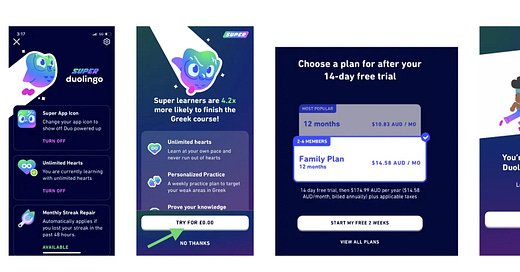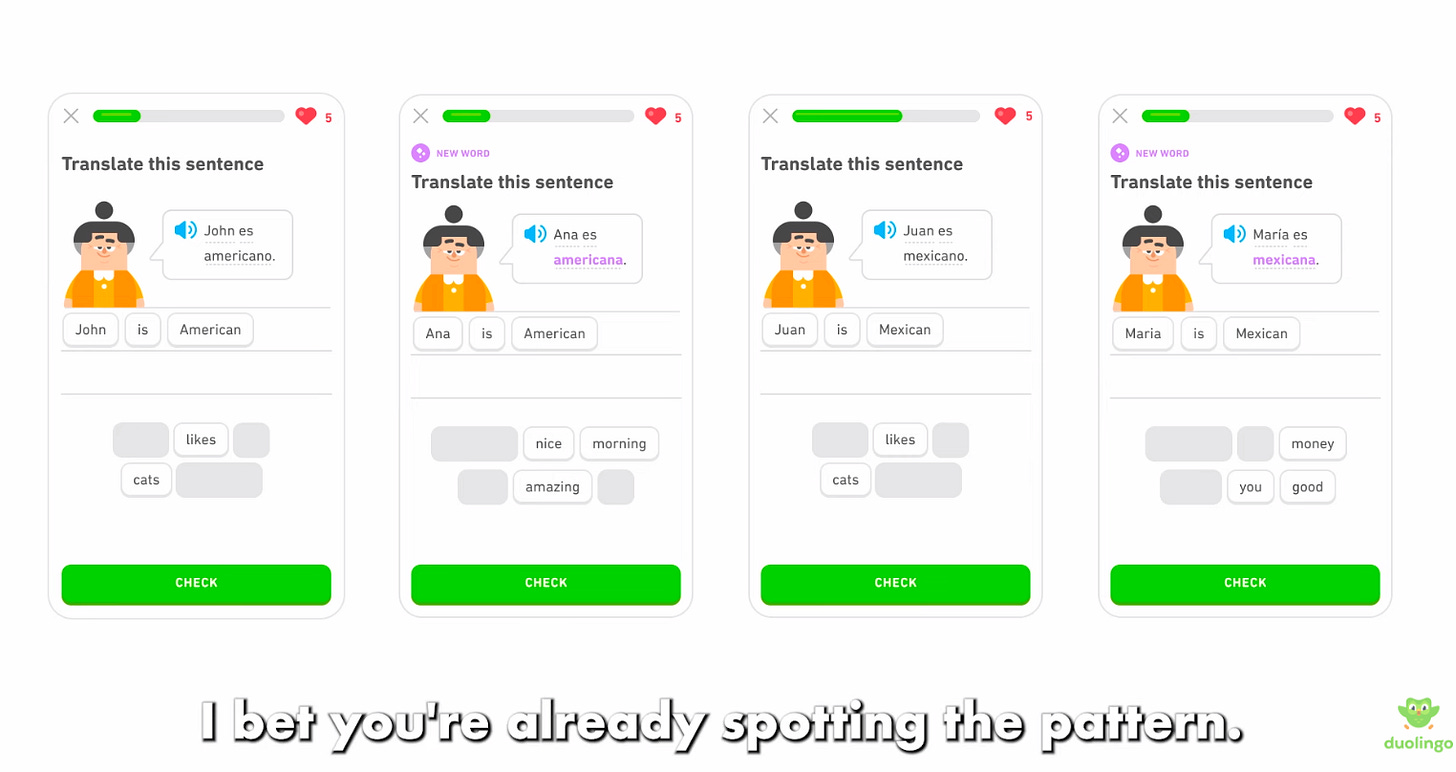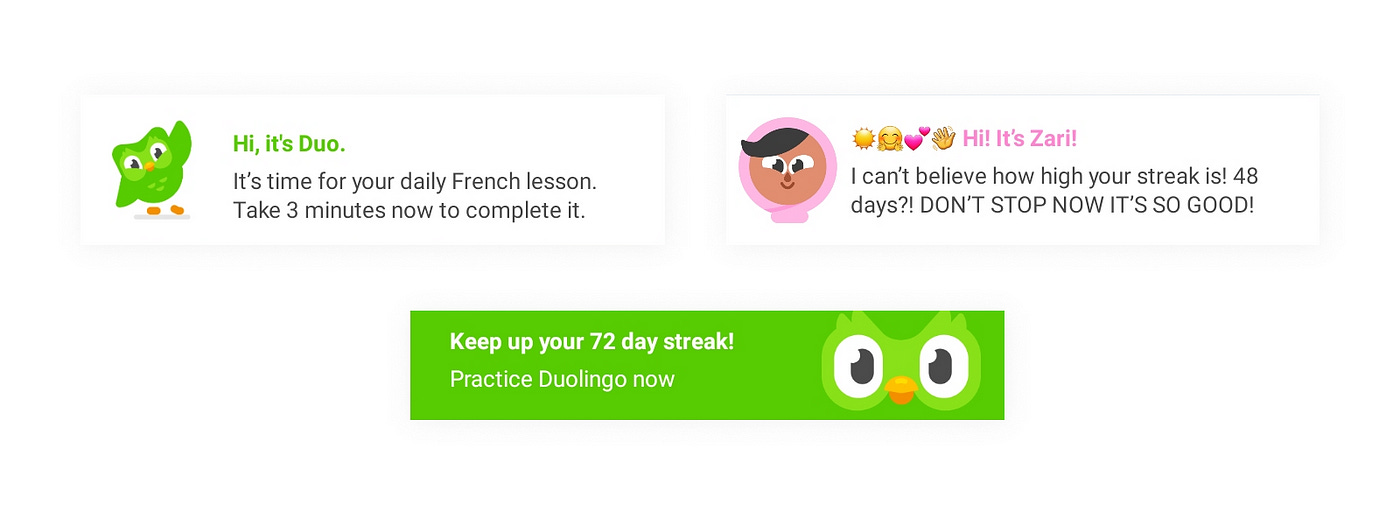Duolingo's killer playbook on activation, engagement, and monetization 🏆😱
👋 Hello and welcome to this week’s subscriber-only *free* growth newsletter, delivered every week straight to your inbox. If you found this helpful, feel free to share with your friends.
As a growth person, my eyes are very attuned to any product’s user experience, user journey, upsell banners, modals, emails, and their mix of growth motions.
If you were to ask me what’s an example of an app that does all of that and more really well, I wouldn’t doubt for a second, naming Duolingo.
I’m in constant awe of everything they do from personalization in onboarding, gamified UX, re-engagement nudges, and upsell strategy.
That’s why I decided to share some of my observations and thoughts about Duolingo’s activation, engagement, and monetization strategy.
“The Duolingo Method”
But how did Duolingo become the number 1 learning platform when it comes to learning languages?
Besides the exceptional gamification and UX, it’s also about how they teach.
I joined Duocon 2023 and learned about “the duolingo method”.
It means learning by doing and letting your brain follow and internalize patterns.
This is exactly how kids learn too.
See an example of how Duolingo teaches you how endings change depending on the sex of the subject in Spanish.
(image from Duocon 2023)
I also learned that part of their success is in personalization powered by AI.
Duolingo uses AI in 2 ways:
Using AI to help you learn (“Explain my answer”, “Role play”).
Using AI to collect and use all the learnings of how everyone learns best and apply it to improve your learning experience (Birdbrain).
They use Birdbrain to predict:
How hard a certain exercise for you is, so you get just the right level of challenge.
The perfect combination and order of exercises in a given lesson.
Some of their ChatGPT-4 powered features are available with the premium tiers, like:
Explain my answer: Using AI to explain why I got the answer wrong or right while using simple non-jargony language.
Role play: It’s a free-form conversation, real conversations with real-time feedback. The conversations are happening with Duolingo characters with unexpected plot twists.
Activation 👋
Now, let's delve into more specific details about how they approach activation, particularly focusing on setup.
Two noteworthy aspects of Duolingo's setup process are:
They use the first-person phrase 'I want to learn...' to make you feel like you own your experience and decision. This approach contrasts with the more traditional 'First Name, Last Name, Email, Country' style, adding extra points to the user's psychological experience without feeling like you've given away too much in return.
After signing up for Duolingo and choosing your language, they prompt you to take a test to determine your level using AI. This helps them find the right level of challenges for you, ensuring it's neither too easy nor too hard.
Engagement 🏆
Duolingo’s engagement strategy is a work of art.
As a B2C company, they know that stickiness and retentions are the biggest hurdles on the path to monetization.
To solve for engagement, they nudge users with in-app notifications, launched their dynamic widget, did an achievements design revamp, and gamified the whole user experience.
Engagement Nudges 💚
Duolingo reminds you to do your lessons and not lose your streak with phone notifications (as long as you have them on).
These are not your regular, dry notifications; they have the personalities of Duolingo's characters. For example, if it's a note from Lily, you'd see her picture, and the tone would be annoyed, in Lily's style.
But that's not the best part yet.
Recently, they launched something special, setting a high bar for others on how to reengage a user.
The usual ways to reengage a user would be sending emails or launching in-app notifications.
However, Duolingo decided to break the mold by creating a whole new category of reengagement nudges - the app widget.
(image from Duolingo’s blog post)
App widgets were traditionally used for displaying stock prices, weather reports, and calendars.
Duolingo's team didn't clutter the widget with additional statistics or context. Instead, they infused it with a lot of personality.
They also made it dynamic, changing 3-5 times a day, every single day.
How did they discover this approach?
They conducted numerous experiments and found that simply reminding a learner of their current streak, and whether or not it's at risk, is highly valuable.
I personally feel super guilty if my Duo is sad or anxious, so I just have to do my 5 min of Spanish. It does the trick!
Achievements Revamp 🥇
Duolingo recently redesigned their achievements section, making it more personalized and appealing.
Each award has a dedicated page where you can learn more about what you've achieved.
(image from Duocon 2023)
They also added something called “personal records”, which are your personal achievements, like perfect lessons, streak days, highest leagues.
Those personal records and achievements help users feel proud of their successes and how far they’ve come, and motivate them to keep on going.
Gamification 🕹️
Acquiring a new skill is time-consuming and requires strong discipline. Many times, we start something new, only to quit after a few weeks or months.
How did Duolingo address this aspect of human psychology?
They gamified the entire user experience from start to finish.
For example:
The introduction of skill levels was their first major success in tackling the learning challenge.
The leaderboard and competitive aspect help users stay motivated.
Rewards and points help users stay engaged.
Monetization 💰
Duolingo knows that the learning process is better and more enjoyable when you have your friends and family learning with you.
So, they created a family account.
It feels like you're getting so much more out of your investment with 5 seats rather than just 1.
And they didn't assume that you'd instantly love this new plan, understanding that trust takes time.
They gave users with a Free Reverse Trial, which grants you access to Super Duolingo (the family account) for 14 days.
Free Reversed Trial is a mix of a free trial and freemium, offering the best of both worlds. It allows users to enjoy all the premium features for free (freemium), but only for a limited period of time (free trial).
The concept of the Free Reversed Trial was created by Elena Verna.
During the 14 day trial, you've likely experienced an 'aha' moment, formed a habit loop, and now have the confidence and trust to upgrade to Super (plus, you get 5 seats for your whole family 😱).
Once the 14 days have passed, they give users two options: keep your Super Duolingo or downgrade back to the free account.
Expansion 🗺️
Duolingo didn’t just stop at languages; they will be expanding into other markets beyond languages but still within the L&D space.
Music and math learning experiences are coming next.











